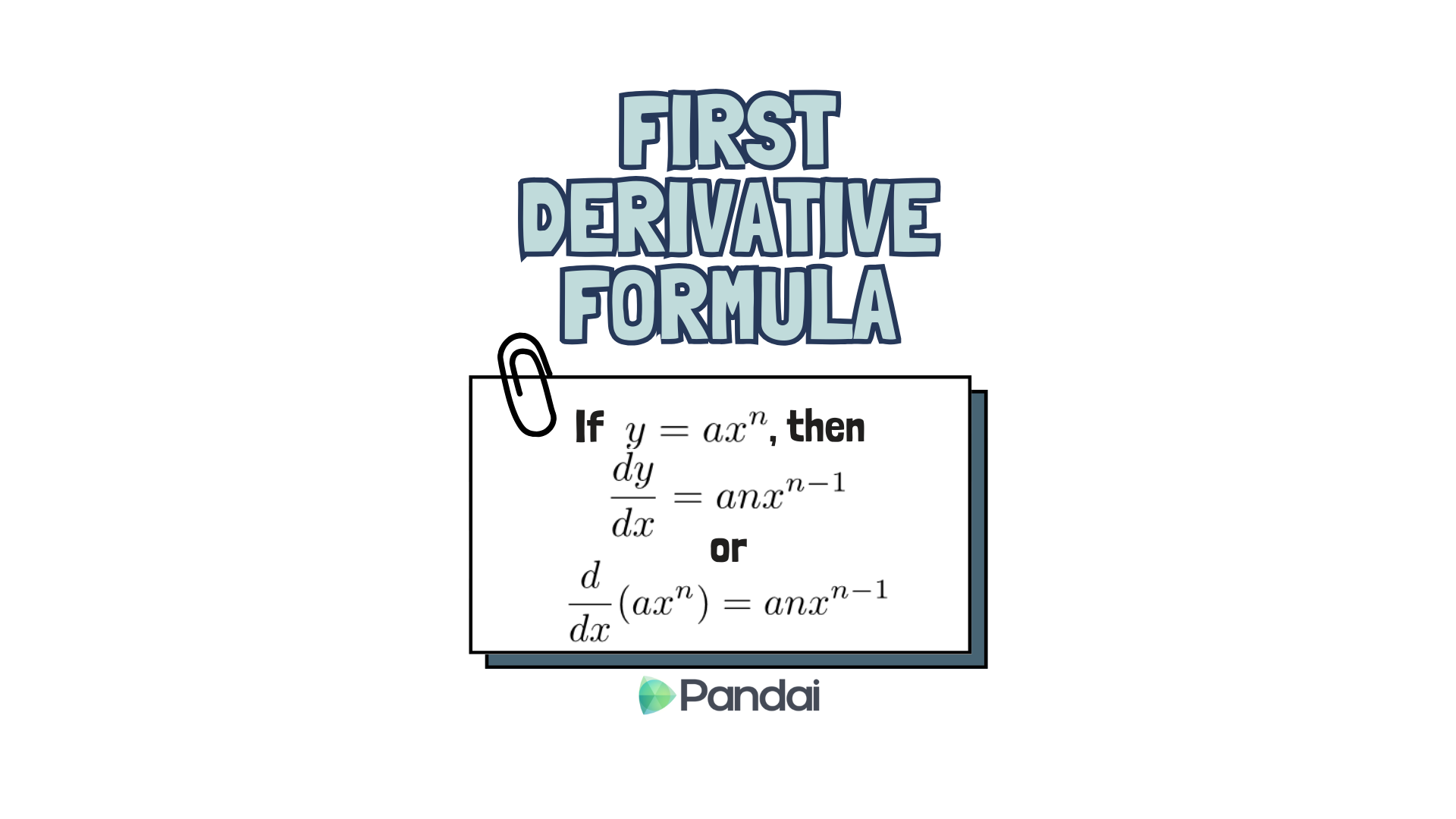| 2.2 |
The First Derivatives |
|
| |
 |
| |
| \(3\) Notations Used to Indicate the First Derivative of a Function \(y=ax^n\) |
- If \(y=3x^2\), then \(\dfrac{dy}{dx}=6x\):
\(\dfrac{dy}{dx}\) is read as differentiating \(y\) with respect to \(x\).
- If \(f(x)=3x^2\), then \(f'(x)=6x\):
\(f'(x)\) is known as the gradient function for the curve \(y=f(x)\) because this function can be used to find the gradient of the curve at any point on the curve.
- \(\dfrac{d}{dx}(3x^2)=6x\):
If differentiating \(3x^2\) with respect to \(x\), the result is \(6x\).
|
|
| |
| Gradient Function |
- The process of determining the gradient function \(f'(x)\) from a function \(y=f(x)\) is known as differentiation.
- The gradient function is also known as the first derivative of the function or the derived function or differentiating coefficient of \(y\) with respect to \(x\).
|
|
| |
| Addition and Subtraction of Functions |
- The derivative of a function which contains terms algebraically added or subtracted can be done by differentiating each term seperately.
- If \(f(x)\) and \(g(x)\) are functions, then
\(\dfrac{d}{dx}[f(x)\pm g(x)]=\dfrac{d}{dx}[f(x)] \pm \dfrac{d}{dx}[g(x)]\).
|
|
|
|
| First Derivative of Composite Function |
|
\(\dfrac{dy}{dx}=\dfrac{dy}{du}\times \dfrac{du}{dx}\)
- If \(y=g(u)\) and \(u=h(x)\), then differentiating \(y\) with respect to \(x\) will give
\(f'(x)=g'(u)\times h'(x)\)
That is, \(\dfrac{dy}{dx}=\dfrac{dy}{du} \times \dfrac{du}{dx}\).
|
|
| |
| First Derivative of a Function involving Product and Quotient of Algebraic Expressions |
|
If \(u\) and \(v\) are functions of \(x\), then
\(\dfrac{d}{dx}(uv)=u\dfrac{dv}{dx}+v\dfrac{du}{dx}\).
|
|
If \(u\) and \(v\) are functions of \(x\), and \(v(x) \neq 0\), then
\(\dfrac{d}{dx} \left( \dfrac{u}{v} \right)=\dfrac{v\dfrac{du}{dx}-u\dfrac{dv}{dx}}{v^2}\).
|
|
| |
| Example \(1\) |
|
Differentiate each of the following with respect to \(x\):
(a) \(y = \dfrac{1}{5}\sqrt x\),
(b) If \(f(x)=\dfrac{3}{4}x^4\), find \(f'(-1)\) and \(f'\left( \dfrac{1}{3} \right)\).
|
|
(a)
\(\begin{aligned} y &= \dfrac{1}{5}\sqrt x\\\\ &= \dfrac{1}{5}x^{\frac{1}{2}}\\\\ \dfrac{dy}{dx} &= \dfrac{1}{5} \begin{pmatrix} {\dfrac{1}{2}x^{\frac{1}{2}-1}} \end{pmatrix} \\\\ &=\dfrac{1}{10}x^{-\frac{1}{2}}\\\\ &= \dfrac{1}{10 \sqrt x} .\end{aligned}\)
(b)
\(\begin{aligned} f(x) &=\dfrac{3}{4}x^4\\\\ f'(x) &= \dfrac{3}{4} (4x^{4-1})\\\\ &= 3x^3\\\\ f'(-1) &= 3(-1)^3\\ &=-3\\\\ f'\left( \dfrac{1}{3} \right)&=3\left( \dfrac{1}{3} \right)^3\\\\ &=\dfrac{1}{9} .\end{aligned}\)
|
|
| |
| Example \(2\) |
|
Differentiate the following expression with respect to \(x\):
\(\dfrac{(2x+1)(x-1)}{x}\)
|
|
Let,
\(\begin{aligned} y &= \dfrac{(2x+1)(x-1)}{x}\\\\ &= \dfrac{2x^2-x-1}{x}\\\\ &=2x-1-x^{-1}. \end{aligned}\)
\(\begin{aligned} \dfrac{dy}{dx} &= \dfrac{d}{dx}(2x) -\dfrac{d}{dx}(1)-\dfrac{d}{dx}(x^{-1})\\\\ &=2x^{1-1} - 0x^{0-1} - (-1x^{-1-1})\\\\ &=2+x^{-2}\\\\ &= 2+ \dfrac{1}{x^2}. \end{aligned}\)
|
|
| |
| Example \(3\) |
|
Differentiate the following function with respect to \(x\):
\(y=(3x^2-4x)^7\)
|
|
Let,
\(u=3x^2-4x\),
\(y=u^7\).
Then,
\(\dfrac{du}{dx}=6x-4\),
\(\dfrac{dy}{du}=7u^6\).
Using chain rule,
\(\begin{aligned} \dfrac{dy}{dx} &= \dfrac{dy}{du} \times \dfrac{du}{dx}\\\\ &=7u^6(6x-4)\\\\ &=7(3x^2-4x)^6(6x-4)\\\\ &= (42x-28)(3x^2-4x)^6\\\\ &=14(3x-2)(3x^2-4x)^6 .\end{aligned}\)
|
|
| |
| Example \(4\) |
|
Given \(y=x \sqrt{x+3}\), find
(a) the expression for \(\dfrac{dy}{dx}\),
(b) the gradient of the tangent at \(x=6\).
|
|
(a)
Let,
\(u=x\),
\(v=\sqrt{x+3}\).
Using the product rule,
\(\begin{aligned} \dfrac{dy}{dx} &= u \dfrac{dv}{dx} + v \dfrac{du}{dx}\\\\ &= x \dfrac{d}{dx} (\sqrt{x+3})+ \sqrt{x+3} \dfrac{d}{dx}x\\\\ &= x \begin{pmatrix} \dfrac{1}{2 \sqrt{x+3}}\end{pmatrix} + \sqrt{x+3} \\\\ &= \dfrac{x+2(x+3)}{2\sqrt{x+3} }\\\\ &= \dfrac{3(x+2)}{2\sqrt{x+3} }. \end{aligned}\)
(b)
When \(x=6\),
\(\begin{aligned} \dfrac{dy}{dx} &= \dfrac{3(6+2)}{2\sqrt{6+3} }\\\\ &=\dfrac{24}{6}\\\\ &= 4. \end{aligned}\)
Thus, gradient of the tangent at \(x=6\) is \(4\).
|
|
| |
| Example \(5\) |
|
Given \(y=\dfrac{2x+1}{x^2-3}\), find \(\dfrac{dy}{dx}\).
|
|
Let,
\(u=2x+1\),
\(v=x^2-3\).
Then,
\(\dfrac{du}{dx}=2\),
\(\dfrac{dv}{dx}=2x\).
\(\begin{aligned} \dfrac{dy}{dx} &= \dfrac{v \dfrac{du}{dx} - u \dfrac{dv}{dx}}{v^2}\\\\ &= \dfrac{(x^2-3)(2)-(2x+1)(2x)}{(x^2-3)^2}\\\\ &= \dfrac{2x^2-6-(4x^2+2x)}{(x^2-3)^2}\\\\ &= \dfrac{-2x^2-2x-6}{(x^2-3)^2}\\\\ &= \dfrac{-2(x^2+x+3)}{(x^2-3)^2}. \end{aligned}\)
|
|
| |